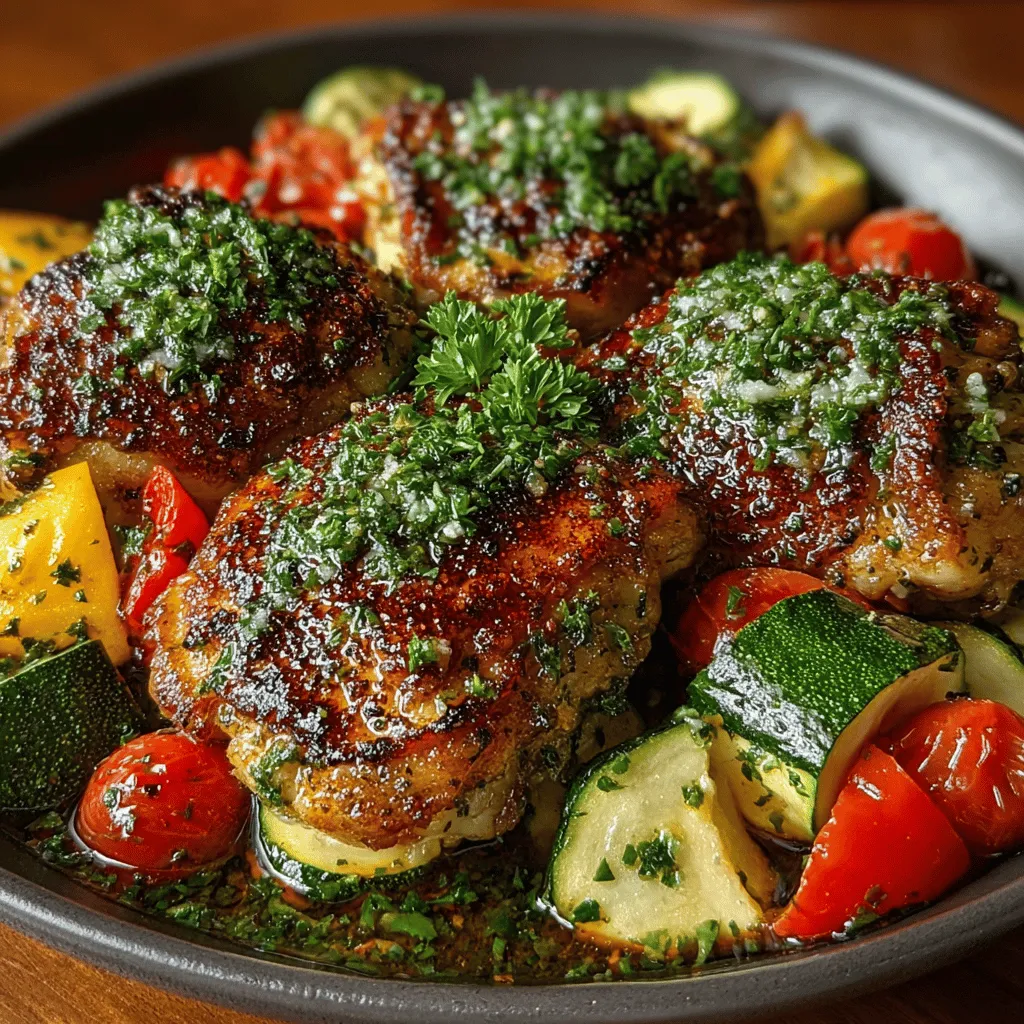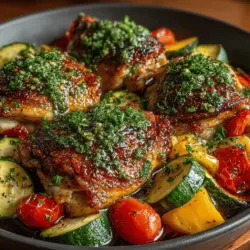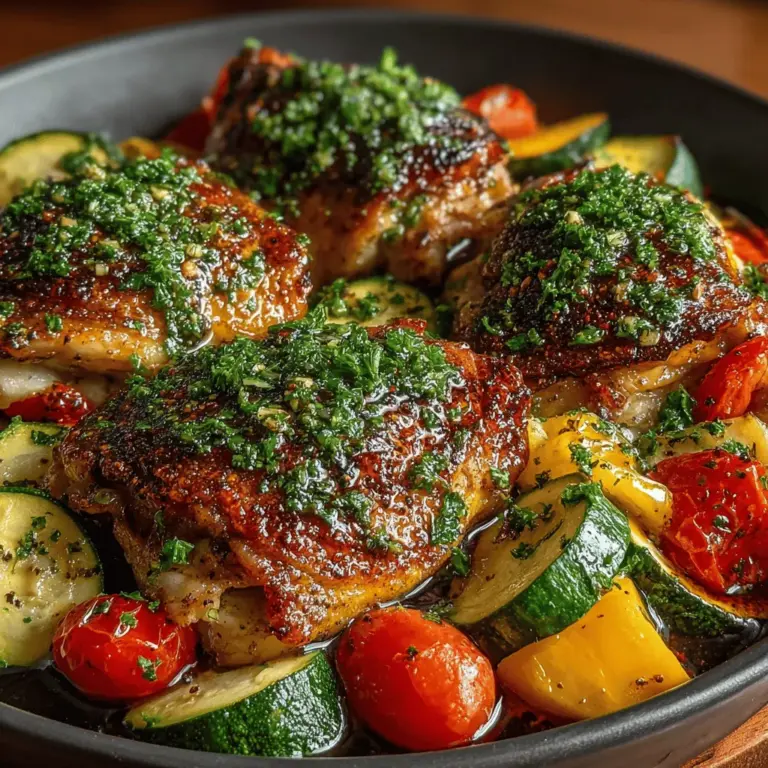Savory Baked Chicken Thighs with Roasted Veggies: A Flavorful Delight
Introduction
In the realm of home-cooked meals, few dishes can rival the heartiness and comfort of savory baked chicken thighs paired with vibrant roasted vegetables. This delightful recipe is more than just a meal; it embodies the warmth of home and the joy of sharing a nourishing dish with loved ones. The combination of juicy chicken thighs and colorful roasted veggies not only tantalizes your taste buds but also provides a nutritious balance of protein and essential vitamins. This makes it a perfect option for family dinners or meal prep, catering to various dietary needs and preferences.
What sets this dish apart is its simplicity; you don’t need to be a culinary expert to create a meal that is both satisfying and impressive. With straightforward ingredients and easy-to-follow steps, you can whip up a delicious dish that is bound to impress even the most discerning palates. In this article, we will explore the intricacies of this recipe, from preparation techniques to cooking methods, ensuring you have all the knowledge you need to make this savory baked chicken thighs with roasted veggies confidently.
Understanding the Ingredients
Exploring the Core Components
To start, let’s take a closer look at the key ingredients that come together to make this dish a savory sensation.
Chicken Thighs
Chicken thighs are the star of this recipe, and for good reason. They are known for their rich flavor and tender texture, making them an ideal choice for baking. Unlike chicken breasts, which can dry out easily, thighs retain moisture during cooking, resulting in juicy bites that are bursting with flavor. They also have a higher fat content, which contributes to a more satisfying mouthfeel and enhanced taste. This makes chicken thighs a favorite among home cooks looking to create a hearty meal without the fuss.
Olive Oil
The role of olive oil in this recipe cannot be overstated. Not only does it serve as the primary cooking fat, providing a luscious coating for the chicken and vegetables, but it also enhances the overall flavor of the dish. Olive oil is rich in monounsaturated fats, which are known to be heart-healthy, and it contains antioxidants that contribute to a well-balanced diet. When used in moderation, olive oil can elevate the taste of your ingredients, bringing out their natural flavors and creating a harmonious blend in every bite.
Fresh Herbs
The importance of fresh herbs in this recipe lies in the aromatic depth they contribute. Rosemary and thyme are two herbs that work particularly well with chicken, infusing the dish with their fragrant oils. Rosemary’s earthy notes complement the savory richness of the chicken, while thyme adds a subtle hint of sweetness. Using fresh herbs instead of dried ones can significantly enhance the flavor profile of your dish, making it more vibrant and appealing.
Spices
In addition to herbs, spices play a crucial role in elevating this dish. Paprika is a standout ingredient that adds a smoky sweetness, while a well-balanced seasoning blend can enhance the overall flavor. A dash of garlic powder or onion powder can also add depth, creating a more complex flavor profile. Using a variety of spices allows you to customize the dish to your preference, ensuring that it resonates with your taste.
Vegetables
Finally, the nutritional profile of the roasted vegetables cannot be overlooked. Zucchini, bell peppers, red onions, and cherry tomatoes all bring their unique flavors and textures, creating a colorful and appetizing presentation. Zucchini provides a subtle sweetness and a satisfying crunch, while bell peppers add a pop of color and a juicy bite. Red onions contribute a slight tang, and cherry tomatoes burst with flavor as they roast, sweetening as they caramelize. Together, these vegetables not only enhance the dish’s visual appeal but also provide essential vitamins and minerals, making this meal a wholesome choice.
Preparation Steps for Flavorful Chicken Thighs
Marinating Techniques for Maximum Flavor
Now that we have a solid understanding of the ingredients, let’s dive into the preparation steps that will ensure your chicken thighs are bursting with flavor.
Creating the Perfect Marinade
To maximize the flavor of your chicken thighs, marination is key. A simple marinade can be created by combining olive oil, minced garlic, and your choice of fresh herbs. This mixture not only adds flavor but also helps to tenderize the meat. A good rule of thumb is to use about ¼ cup of olive oil for every pound of chicken, along with 2-3 cloves of minced garlic and a tablespoon of each herb. Whisk these ingredients together until well combined, then pour them over the chicken thighs in a resealable plastic bag or a shallow dish.
The Science Behind Marination
Understanding the science behind marination can help you achieve the best results. Marinating chicken allows the flavors to penetrate the meat, making it more flavorful. The acid in the marinade (from garlic or any added citrus) can help break down proteins, tenderizing the chicken and making it more succulent. However, timing matters: if chicken is left to marinate for too short a time, the flavors won’t fully develop; conversely, if left for too long, the texture can become mushy. A marination time of 30 minutes to 4 hours is often ideal, allowing the chicken to absorb the flavors without compromising its texture.
Suggestions for Marination Duration
For those in a rush, even a quick 30-minute marination can impart significant flavor. However, for the best results, aim for a longer marination time, ideally around 2-4 hours. If you have the time, consider marinating the chicken overnight in the refrigerator. This allows the flavors to fully meld and penetrate the meat, resulting in a more flavorful and tender dish when cooked.
Preparing the Veggies for Roasting
Choosing and Cutting Your Vegetables
With the chicken marinating, it’s time to turn our attention to the vegetables that will accompany it. Selecting and preparing fresh vegetables is crucial for achieving the best flavor and texture in your dish.
Tips for Selecting Fresh Vegetables
When shopping for vegetables, look for those that are vibrant in color and firm to the touch. Avoid any produce that appears wilted or has soft spots, as these can indicate age and loss of flavor. For this recipe, choose zucchini that are small to medium-sized, as they will be tender and flavorful. Opt for bell peppers in a variety of colors for visual appeal, and select red onions that are firm and heavy for their size. Cherry tomatoes should be bright and plump, signaling their ripeness and sweetness.
Cutting the Vegetables
Once you have your fresh produce, the next step is to cut them into even pieces. This ensures that they cook uniformly and develop a consistent texture when roasted. For zucchini, slice them into half-moons about ½ inch thick to allow for even roasting. Bell peppers should be cut into strips or bite-sized chunks, while red onions can be sliced into wedges. Cherry tomatoes can be left whole or halved, depending on your preference. Uniform cutting not only helps with cooking but also enhances the dish’s presentation, making it visually appealing.
By carefully selecting and preparing your ingredients, you set the stage for a truly flavorful dish. In the next section, we will delve into the cooking techniques that will bring your savory baked chicken thighs and roasted veggies to life, ensuring every bite is a delight.

The Best Cutting Techniques for Even Roasting: Slicing and Dicing Explained
To achieve perfectly roasted vegetables that complement your savory baked chicken thighs, mastering the art of cutting is essential. Using the right cutting techniques ensures that all your vegetables are evenly sized, promoting consistent cooking and enhancing their flavors.
Slicing Techniques
For larger vegetables like bell peppers and zucchini, slicing them into uniform pieces, about 1-inch thick, is ideal. This size allows them to cook evenly without becoming mushy. If you’re using root vegetables such as carrots or potatoes, consider cutting them into similar-sized sticks or rounds to match the cooking time of your chicken.
Dicing Techniques
Dicing is perfect for smaller vegetables like onions or garlic. Aim for a fine dice to ensure they cook quickly and integrate well with the other ingredients. When dicing, keep your knife skills sharp and your fingers tucked away to avoid any accidents.
Combining Flavors: How Balsamic Vinegar Enhances the Vegetable Mix
Balsamic vinegar is a magical ingredient that elevates the flavor profile of roasted vegetables. Its sweet and tangy notes create a beautiful contrast with the savory tones of the chicken. When you drizzle balsamic vinegar over your vegetable mix before roasting, it caramelizes as it cooks, adding depth and richness to your dish.
Baking the Chicken and Vegetables
Achieving the Perfect Bake
Once your chicken thighs and vegetables are prepped, it’s time to get them in the oven. Here’s how to ensure everything cooks to perfection.
Preheating the Oven: Importance of Temperature Control
Always preheat your oven to 425°F (220°C) before placing your dish inside. This high temperature is crucial for achieving a crispy skin on the chicken while roasting the vegetables to a delightful tenderness. Skipping this step can lead to uneven cooking and a less appealing texture.
Arranging on the Baking Sheet: Optimal Spacing for Even Cooking
When you place your chicken thighs and vegetables on the baking sheet, make sure to arrange them with ample space in between. Crowding the pan can cause steaming, which prevents browning. A good rule of thumb is to leave about an inch of space between pieces. This allows hot air to circulate freely, ensuring that everything cooks evenly and achieves that desirable golden-brown finish.
Understanding Cooking Times: How to Tell When Your Chicken is Done
The cooking time for your chicken thighs will vary depending on their size. Generally, bone-in, skin-on chicken thighs require about 35 to 45 minutes in a preheated oven. To check for doneness, use a meat thermometer to ensure the internal temperature reaches 165°F (75°C). Additionally, the juices should run clear, indicating that the chicken is fully cooked.
Serving Suggestions and Presentation
Making Your Meal Visually Appealing
An inviting presentation can elevate your dish from ordinary to extraordinary.
Tips for Plating: Creating an Inviting Presentation
When serving your savory baked chicken thighs, consider layering your plate. Start with a bed of roasted vegetables, then place the chicken thigh on top. This not only looks appealing but allows the flavors to meld together. Use a large platter for family-style serving, or individual plates for a formal setting.
Garnishing with Fresh Parsley: Enhancing Flavor and Color
To add a pop of color and freshness to your dish, garnish with freshly chopped parsley. Not only does it enhance the visual appeal, but parsley also adds a bright, herbal flavor that complements the richness of the chicken and the sweetness of the roasted veggies.
Pairing Options: Suggestions for Sides or Accompaniments
For a well-rounded meal, consider pairing your savory baked chicken thighs with a side salad or a grain like quinoa or couscous. A simple arugula salad with a lemon vinaigrette can provide a refreshing contrast to the richness of the chicken. Alternatively, a crusty loaf of bread or garlic bread could be a delightful accompaniment, perfect for soaking up any juices left on your plate.
Nutritional Benefits of the Dish
Health Aspects of Chicken and Vegetables
This dish is not only flavorful but also packed with nutritional value.
The Nutritional Value of Chicken Thighs: Protein and Fat Content
Chicken thighs are an excellent source of protein, providing about 26 grams of protein per 3.5-ounce serving. They also contain healthy fats, which help to keep you satisfied and can aid in the absorption of fat-soluble vitamins. While chicken thighs have a higher fat content than chicken breasts, this fat contributes to their rich flavor and juiciness.
Benefits of a Vegetable-Rich Diet: Vitamins and Minerals in the Dish
The vegetables in this recipe—such as bell peppers, zucchini, and onions—are rich in vitamins and minerals essential for overall health. They provide dietary fiber, which aids digestion, as well as vitamins A and C, which are crucial for immune function and skin health. A diet abundant in vegetables can also reduce the risk of chronic diseases and support healthy weight management.
Balancing Macros in Your Meal: Understanding the Importance of Protein, Fats, and Carbs
This dish strikes a great balance between protein, healthy fats, and complex carbohydrates, making it a well-rounded meal option. The chicken provides a solid protein base, while the fats from olive oil and chicken skin contribute to satiety. The vegetables serve as a source of carbohydrates, offering essential nutrients without excessive calories. Understanding these macronutrients can help you create meals that nourish your body while satisfying your taste buds.
Conclusion
Savory baked chicken thighs with roasted veggies not only deliver on flavor but also cater to a balanced diet. This dish is a perfect example of how simple ingredients can come together to create a delightful meal that nourishes both body and soul. By mastering the preparation and cooking techniques outlined here, you can serve up a dish that is sure to become a staple in your culinary repertoire. Whether you’re cooking for family or hosting friends, this recipe promises satisfaction and enjoyment at the dining table.
With its rich flavors, vibrant colors, and impressive nutritional profile, this meal stands as a testament to the joy of home-cooked food. Embrace the process of cooking, and remember that each step, from cutting techniques to plating, contributes to the overall experience. As you enjoy your savory baked chicken thighs with roasted veggies, take pride in the delicious meal you’ve created and the memories shared around the table.

